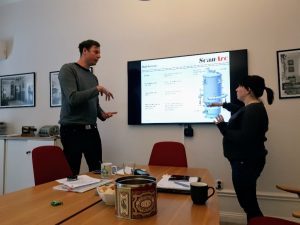“It must be very challenging to try to understand all these chains of processes”, said Daniel, an industrial partner from ScanArc Plasma Technologies AB, as he kindly drove us to the train station after our company visit.

The irony of a thermochemical company building being covered with snow
In this blog entry, I would like to bring you the perspective of a system analyst battling through one of the most tedious yet critical tasks: data collection. Through the narrative of our recent company visits, our general remarks for performing data collection, at least how we do it in Work Package 4, are elaborated here.
Building rapport
A thorough understanding of the system processes is one of the core requirements in doing a sound sustainability assessment. In addition to reviewing related literature, for us, it means actual interaction with experts. Understanding the entire Enhanced Landfill Mining (ELFM) process chain means communicating with the other ESRs and the various companies. By experience, communication is better done in person to build rapport, especially from the beginning. As it is expected to work together throughout the entire project, we see a good relationship as one of the important factors that can ease and loosen up the bilateral flow of information. In this way, we understand not just the technical processes, but also have an idea about the organizational and decision-making criteria. For example, we initially considered that plasma gasification would be a very sensitive process where the feedstock composition needs to be strictly defined, in comparison to that of conventional incineration. But instead, we now understand that carbon-rich feedstock like wood and coke can also be added.
Braving unknown places and unexpected circumstances
I still remember the fickle-minded Belgian sky in our last visit at the landfill excavation in Mont Saint Guibert. I only stayed for a day, but Work Package 1 was there for about a week and ‘enjoyed’ a lot more the alternating sunny and rainy weather in combination with strong wind while dealing with excavated wastes. Now, it is my time to deepen my knowledge and gain more experience with the ELFM process that is thermal treatment through plasma gasification.

My colleague ESR Giovanna and me keep smiling through our adventure.
ScanArc is one of the industrial partners of NEW-MINE and works in research and development of plasma gasification, among others. Their company is situated in Höfors, Sweden (not in Stockholm as I always thought of during network events), about 350 km northwest of Linköping where my university is located. Considering the vast Swedish land, travelling there requires more than 5 hours of train ride including inevitable transfers, as it is not a common destination (basically, it is in the middle of nowhere if I may say). With the snowstorm to blame, our afternoon train was cancelled which had a domino effect on all our transfers. Fortunately, the train company availed a taxi service for us all the way to our hotel. Proper logistics and staying calm in these unexpected circumstances were necessary. Otherwise, it would have messed up our scheduled meeting and planned presentation on the following day.
Leveling-off understanding and expectations

Daniel and Maria of ScanArc explaining the PyroArc technology
Prior to the actual company visit, we made sure that we were fully prepared when it comes to knowing the company background and the research they have done and are currently doing. In addition, we did further reading to see the company’s research relative to the entire field’s state-of-the-art. Typically, we prepared a short presentation including our preliminary understanding of the process and related sustainability assessments. Apart from our process understanding, we also clarified our research objectives. It is very important to do so, because the company may not exactly agree totally on our pre-defined objectives, which is understandable as we bring in a perspective from academia. So early on in the research process, these perspectives need to be balanced and research objectives need to be refined so that they would be beneficial to both parties. On site, the company introduced us to their specific technology – some information remains confidential and we can only discuss it while meeting them. Their data was an important piece of the puzzle when overseeing the total ELFM process chain.
Implementing an iterative approach
Borrowing the standard framework for life cycle assessment, an iterative approach has to be implemented throughout the research process—from the setting of shared research goals and scope, to data collection, and up to environmental (and economic) impact assessments. Now that we are in the tedious part of data collection and preliminary process modelling, iterative do-and-check process together with the companies and the other ESRs are necessary. Working in close collaboration is imperative as we are aiming to cover the uncertainties of the ELFM process chain that occur in the model, scenario and parameter level. This aids us not just towards the completion of data inventory but even further on with the validation of our assessment model and eventually production of results that are sensible and reliable.
Next week, we will be presenting our initial data inventory and modelling results at ScanArc office! We wish to have a better weather by then and of course, a fruitful discussion.
About the Author:

Jay-el hails from the sunny Philippines and now residing in chilly Sweden. He has also lived in several parts of Europe such as The Netherlands and Belgium as part of his study and research mobility. He misses Philippine mangoes and white sand beaches, but he also enjoys Swedish meatballs and glacial lakes. His passion for sustainability was honed by taking the Erasmus Mundus Masters in Industrial Ecology. He is currently taking a Double Doctorate Degree in Sustainable Systems and Applied Economics between Linköping University in Sweden and University of Antwerp in Belgium, respectively. His research topic is about the techno-economic and multi-criteria assessments of enhanced landfill mining concepts and technologies. |


